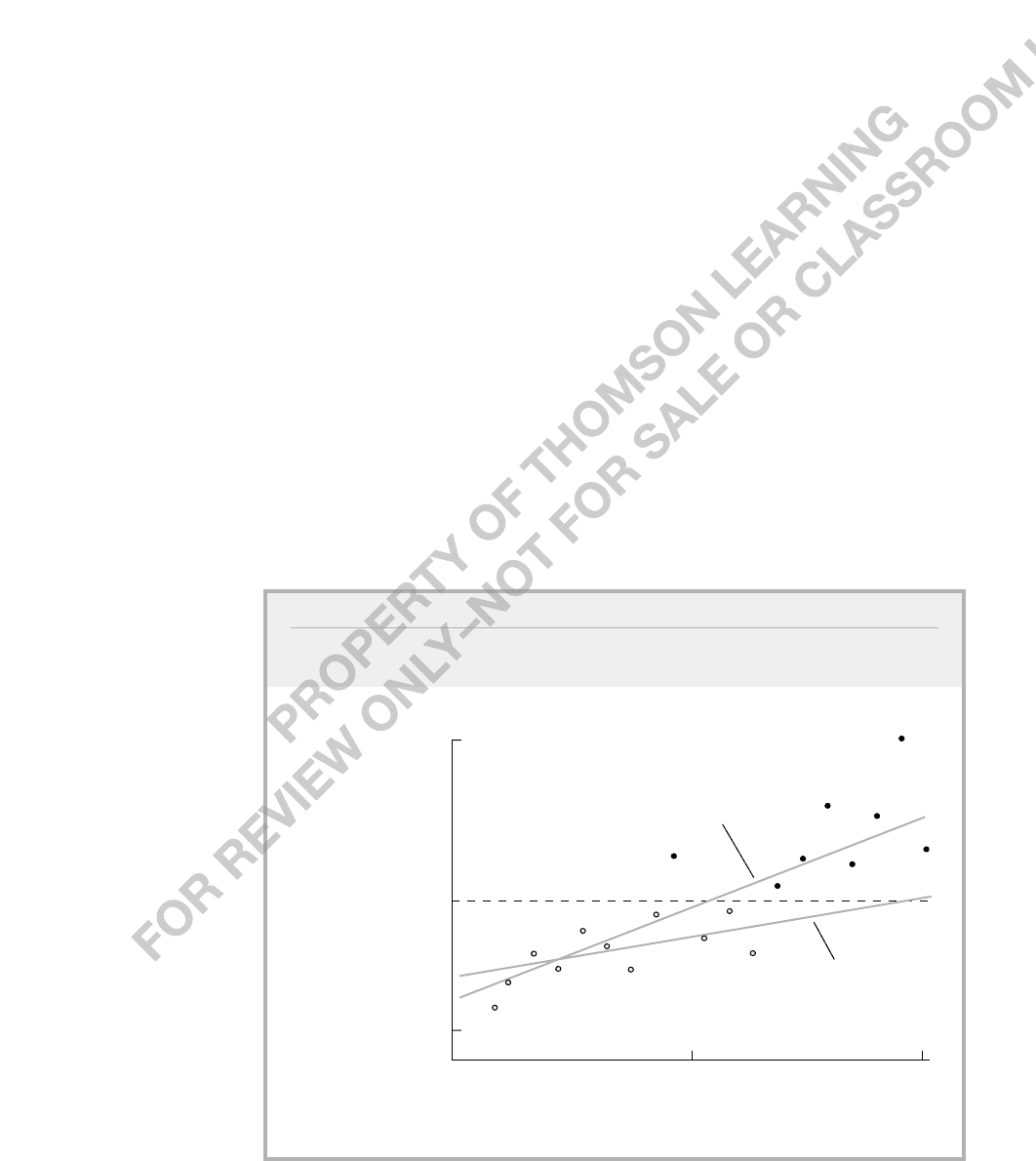Wooldridge J. Introductory Econometrics: A Modern Approach (Basic Text - 3d ed.)
Подождите немного. Документ загружается.


where we drop the term log(y
i
!) because it does not depend on
. This log-likelihood
function is simple to maximize, although the Poisson MLEs are not obtained in closed
form.
The standard errors of the Poisson estimates
ˆ
j
are easy to obtain after the log-
likelihood function has been maximized; the formula is in the chapter appendix. These are
reported along with the
ˆ
j
by any software package.
As with the probit, logit, and Tobit models, we cannot directly compare the magni-
tudes of the Poisson estimates of an exponential function with the OLS estimates of a
linear function. Nevertheless, a rough comparison is possible, at least for continuous
explanatory variables. If (17.31) holds, then the partial effect of x
j
with respect to E(yx
1
,
x
2
,...,x
k
) is ∂E(yx
1
,x
2
,...,x
k
)/x
j
exp(
0
1
x
1
...
k
x
k
) ·
j
. This expression follows
from the chain rule in calculus because the derivative of the exponential function is just
the exponential function. If we let
ˆ
j
denote an OLS slope coefficient from the regression
y on x
1
,x
2
,...,x
k
, then we can roughly compare the magnitude of the
ˆ
j
and the average
partial effect for an exponential regression function, namely, [n
1
n
i1
exp(
ˆ
0
ˆ
1
x
i1
...
ˆ
k
x
ik
)]
ˆ
j
.
Although Poisson MLE analysis is a natural first step for count data, it is often much
too restrictive. All of the probabilities and higher moments of the Poisson distribution are
determined entirely by the mean. In particular, the variance is equal to the mean:
Var ( yx) E(yx).
(17.34)
This is restrictive and has been shown to be violated in many applications. Fortunately,
the Poisson distribution has a very nice robustness property: whether or not the Poisson
distribution holds, we still get consistent, asymptotically normal estimators of the
j
. (See
Wooldridge [2002, Chapter 19] for details.) This is analogous to the OLS estimator, which
is consistent and asymptotically normal whether or not the normality assumption holds;
yet OLS is the MLE under normality.
When we use Poisson MLE, but we do not assume that the Poisson distribution is
entirely correct, we call the analysis quasi-maximum likelihood estimation (QMLE).
The Poisson QMLE is very handy because it is programmed in many econometrics pack-
ages. However, unless the Poisson variance assumption (17.34) holds, the standard errors
need to be adjusted.
A simple adjustment to the standard errors is available when we assume that the vari-
ance is proportional to the mean:
Var ( yx)
2
E(yx),
(17.35)
where
2
0 is an unknown parameter. When
2
1, we obtain the Poisson variance
assumption. When
2
1, the variance is greater than the mean for all x; this is called
overdispersion because the variance is larger than in the Poisson case, and it is observed
in many applications of count regressions. The case
2
1, called underdispersion, is less
common but is allowed in (17.35).
Under (17.35), it is easy to adjust the usual Poisson MLE standard errors. Let
ˆ
j
denote the Poisson QMLE and define the residuals as u
ˆ
i
y
i
y
ˆ
i
,where y
ˆ
i
exp(
ˆ
0
606 Part 3 Advanced Topics

ˆ
1
x
i1
…
ˆ
k
x
ik
) is the fitted value. As usual, the residual for observation i is the
difference between y
i
and its fitted value. A consistent estimator of
2
is (n k 1)
1
n
i1
u
ˆ
i
2
/y
ˆ
i
,where the division by y
ˆ
i
is the proper heteroskedasticity adjustment, and
n k 1 is the df given n observations and k 1 estimates
ˆ
0
,
ˆ
1
,…,
ˆ
k
.
Letting
ˆ
be the positive square root of
ˆ
2
,we multiply the usual Poisson standard errors
by
ˆ
. If
ˆ
is notably greater than one, the corrected standard errors can be much bigger
than the nominal, generally incorrect, Poisson MLE standard errors.
Even (17.35) is not entirely general. Just as in the linear model, we can obtain stan-
dard errors for the Poisson QMLE that do not restrict the variance at all. (See Wooldridge
[2002, Chapter 19] for further explanation.)
Under the Poisson distributional assumption, we can use the likelihood ratio statistic
to test exclusion restrictions, which, as always, has the form in (17.12). If we have q exclu-
sion restrictions, the statistic is distributed
approximately as
q
2
under the null. Under
the less restrictive assumption (17.35), a
simple adjustment is available (and then
we call the statistic the quasi-likelihood
ratio statistic): we divide (17.12) by
ˆ
2
,
where
ˆ
2
is obtained from the unrestricted
model.
EXAMPLE 17.3
(Poisson Regression for Number of Arrests)
We now apply the Poisson regression model to the arrest data in CRIME1.RAW, used, among
other places, in Example 9.1. The dependent variable, narr86, is the number of times a man
is arrested during 1986. This variable is zero for 1,970 of the 2,725 men in the sample, and
only eight values of narr86 are greater than five. Thus, a Poisson regression model is more
appropriate than a linear regression model. Table 17.3 also presents the results of OLS esti-
mation of a linear regression model.
The standard errors for OLS are the usual ones; we could certainly have made these robust
to heteroskedasticity. The standard errors for Poisson regression are the usual maximum like-
lihood standard errors. Because
ˆ
1.232, the standard errors for Poisson regression should
be inflated by this factor (so each corrected standard error is about 23% higher). For exam-
ple, a more reliable standard error for tottime is 1.23(.015) .0185, which gives a t statistic
of about 1.3. The adjustment to the standard errors reduces the significance of all variables,
but several of them are still very statistically significant.
The OLS and Poisson coefficients are not directly comparable, and they have very different
meanings. For example, the coefficient on pcnv implies that, if pcnv .10, the expected
number of arrests falls by .013 (pcnv is the proportion of prior arrests that led to conviction).
The Poisson coefficient implies that pcnv .10 reduces expected arrests by about 4%
[.402(.10) .0402, and we multiply this by 100 to get the percentage effect]. As a policy
matter, this suggests we can reduce overall arrests by about 4% if we can increase the prob-
ability of conviction by .1.
Chapter 17 Limited Dependent Variable Models and Sample Selection Corrections 607
Suppose that we obtain
ˆ
2
2. How will the adjusted standard
errors compare with the usual Poisson MLE standard errors? How
will the quasi-LR statistic compare with the usual LR statistic?
QUESTION 17.4

TABLE 17.3
Determinants of Number of Arrests for Young Men
Dependent Variable: narr86
Independent Linear Exponential
Variables (OLS) (Poisson QMLE)
pcnv .132 .402
(.040) (.085)
avgsen .011 .024
(.012) (.020)
tottime .012 .024
(.009) (.015)
ptime86 .041 .099
(.009) (.021)
qemp86 .051 .038
(.014) (.029)
inc86 .0015 .0081
(.0003) (.0010)
black .327 .661
(.045) (.074)
hispan .194 .500
(.040) (.074)
born60 .022 .051
(.033) (.064)
constant .577 .600
(.038) (.067)
Log-Likelihood Value — 2,248.76
R-Squared .073 .077
ˆ
.829 1.232
608 Part 3 Advanced Topics

The Poisson coefficient on black implies that, other factors being equal, the expected num-
ber of arrests for a black man is estimated to be about 100 [exp(.661) 1]
93.7% higher
than for a white man with the same values for the other explanatory variables.
As with the Tobit application in Table 17.2, we report an R-squared for Poisson regression:
the squared correlation coefficient between y
i
and y
ˆ
i
exp(
ˆ
0
ˆ
1
x
i1
…
ˆ
k
x
ik
). The moti-
vation for this goodness-of-fit measure is the same as for the Tobit model. We see that the
exponential regression model, estimated by Poisson QMLE, fits slightly better. Remember that
the OLS estimates are chosen to maximize the R-squared, but the Poisson estimates are not.
(They are selected to maximize the log-likelihood function.)
Other count data regression models have been proposed and used in applications, which
generalize the Poisson distribution in a variety of ways. If we are interested in the effects
of the x
j
on the mean response, there is little reason to go beyond Poisson regression: it is
simple, often gives good results, and has the robustness property discussed earlier. In fact,
we could apply Poisson regression to a y that is a Tobit-like outcome, provided (17.31)
holds. This might give good estimates of the mean effects. Extensions of Poisson regres-
sion are more useful when we are interested in estimating probabilities, such as P(y 1x).
(See, for example, Cameron and Trivedi [1998].)
17.4 Censored and Truncated Regression Models
The models in Sections 17.1, 17.2, and 17.3 apply to various kinds of limited dependent
variables that arise frequently in applied econometric work. In using these methods, it is
important to remember that we use a probit or logit model for a binary response, a Tobit
model for a corner solution outcome, or a Poisson regression model for a count response
because we want models that account for important features of the distribution of y. There
is no issue of data observability. For example, in the Tobit application to women’s labor
supply in Example 17.2, there is no problem with observing hours worked: it is simply
the case that a nontrivial fraction of married women in the population choose not to work
for a wage. In the Poisson regression application to annual arrests, we observe the depen-
dent variable for every young man in a random sample from the population, but the depen-
dent variable can be zero as well as other small integer values.
Unfortunately, the distinction between lumpiness in an outcome variable (such as taking
on the value zero for a nontrivial fraction of the population) and problems of data censoring
can be confusing. This is particularly true when applying the Tobit model. In this book,
the standard Tobit model described in Section 17.2 is only for corner solution outcomes. But
the literature on Tobit models usually treats another situation within the same framework: the
response variable has been censored above or below some threshold. Typically, the censoring
is due to survey design and, in some cases, institutional constraints. Rather than treat data
censoring problems along with corner solution outcomes, we solve data censoring by apply-
ing a censored regression model. Essentially, the problem solved by a censored regression
model is one of missing data on the response variable, y,but where we have information about
the variable when it is missing, namely, whether it is above or below a known threshold.
Chapter 17 Limited Dependent Variable Models and Sample Selection Corrections 609

A truncated regression model arises when we exclude, on the basis of y,a subset of the
population in our sampling scheme. In other words, we do not have a random sample from
the underlying population, but we know the rule that was used to include units in the sam-
ple. This rule is determined by whether y is above or below a certain threshold. We explain
more fully the difference between censored and truncated regression models later.
Censored Regression Models
While censored regression models can be defined without distributional assumptions, in
this subsection we study the censored normal regression model. The variable we would
like to explain, y,follows the classical linear model. For emphasis, we put an i subscript
on a random draw from the population:
y
i
0
x
i
u
i
, u
i
x
i
,c
i
~ Normal(0,
2
) (17.36)
w
i
min(y
i
,c
i
). (17.37)
Rather than observing y
i
, we only observe it if it is less than a censoring value, c
i
. Notice
that (17.36) includes the assumption that u
i
is independent of c
i
. (For concreteness, we
explicitly consider censoring from above,
or right censoring; the problem of cen-
soring from below, or left censoring,is
handled similarly.)
One example of right data censoring is
top coding. When a variable is top coded,
we know its value only up to a certain
threshold. For responses greater than the
threshold, we only know that the variable
is at least as large as the threshold. For
example, in some surveys, family wealth
is top coded. Suppose that respondents are
asked their wealth, but people are allowed
to respond with “more than $500,000.” Then, we observe actual wealth for those respon-
dents whose wealth is less than $500,000 but not for those whose wealth is greater than
$500,000. In this case, the censoring threshold, c
i
, is the same for all i. In many situa-
tions, the censoring threshold changes with individual or family characteristics.
If we observed a random sample for (x,y), we would simply estimate
by OLS, and
statistical inference would be standard. (We again absorb the intercept into x for simplic-
ity.) The censoring causes problems. Using arguments similar to the Tobit model, an OLS
regression using only the uncensored observations—that is, those with y
i
c
i
—produces
inconsistent estimators of the
j
. An OLS regression of w
i
on x
i
, using all observations,
does not consistently estimate the
j
, unless there is no censoring. This is similar to the
Tobit case, but the problem is much different. In the Tobit model, we are modeling eco-
nomic behavior, which often yields zero outcomes; the Tobit model is supposed to reflect
this. With censored regression, we have a data collection problem because, for some rea-
son, the data are censored.
610 Part 3 Advanced Topics
Let mvp
i
be the marginal value product for worker i; this is the
price of a firm’s good multiplied by the marginal product of the
worker. Assume mvp
i
is a linear function of exogenous variables,
such as education, experience, and so on, and an unobservable
error. Under perfect competition and without institutional con-
straints, each worker is paid his or her marginal value product. Let
minwage
i
denote the minimum wage for worker i, which varies by
state. We observe wage
i
, which is the larger of mvp
i
and
minwage
i
. Write the appropriate model for the observed wage.
QUESTION 17.5

Under the assumptions in (17.36) and (17.37), we can estimate
(and
2
) by maxi-
mum likelihood, given a random sample on (x
i
,w
i
). For this, we need the density of w
i
,
given (x
i
,c
i
). For uncensored observations, w
i
y
i
, and the density of w
i
is the same as
that for y
i
: Normal(x
i
,
2
). For censored observations, we need the probability that w
i
equals the censoring value, c
i
,given x
i
:
P(w
i
c
i
x
i
) P(y
i
c
i
x
i
) P(u
i
c
i
x
i
) 1 [(c
i
x
i
)/
].
We can combine these two parts to obtain the density of w
i
,given x
i
and c
i
:
f(wx
i
,c
i
) 1 [(c
i
x
i
)/
], w c
i
,
(17.38)
(1/
)
[(w x
i
)/
], w c
i
. (17.39)
The log-likelihood for observation i is obtained by taking the natural log of the density
for each i. We can maximize the sum of these across i, with respect to the
j
and
,to
obtain the MLEs.
It is important to know that we can interpret the
j
just as in a linear regression model
under random sampling. This is much different than the Tobit applications, where the
expectations of interest are nonlinear functions of the
j
.
An important application of censored regression models is duration analysis. A dura-
tion is a variable that measures the time before a certain event occurs. For example, we
might wish to explain the number of days before a felon released from prison is arrested.
For some felons, this may never happen, or it may happen after such a long time that we
must censor the duration in order to analyze the data.
In duration applications of censored normal regression, as well as in top coding, we
often use the natural log as the dependent variable, which means we also take the log of
the censoring threshold in (17.37). As we have seen throughout this text, using the log
transformation for the dependent variable causes the parameters to be interpreted as per-
centage changes. Further, as with many positive variables, the log of a duration typically
has a distribution closer to normal than the duration itself.
EXAMPLE 17.4
(Duration of Recidivism)
The file RECID.RAW contains data on the time in months until an inmate in a North Carolina
prison is arrested after being released from prison; call this durat. Some inmates participated
in a work program while in prison. We also control for a variety of demographic variables, as
well as for measures of prison and criminal history.
Of 1,445 inmates, 893 had not been arrested during the period they were followed; there-
fore, these observations are censored. The censoring times differed among inmates, ranging
from 70 to 81 months.
Table 17.4 gives the results of censored normal regression for log(durat). Each of the coef-
ficients, when multiplied by 100, gives the estimated percentage change in expected duration
given a ceteris paribus increase of one unit in the corresponding explanatory variable.
Chapter 17 Limited Dependent Variable Models and Sample Selection Corrections 611

TABLE 17.4
Censored Regression Estimation of Criminal Recidivism
Dependent Variable: log(durat)
Coefficient
Independent Variables (Standard Error)
workprg .063
(.120)
priors .137
(.021)
tserved .019
(.003)
felon .444
(.145)
alcohol .635
(.144)
drugs .298
(.133)
black .543
(.117)
married .341
(.140)
educ .023
(.025)
age .0039
(.0006)
constant 4.099
(.348)
Log-Likelihood Value 1,597.06
ˆ
1.810
612 Part 3 Advanced Topics

Several of the coefficients in Table 17.4 are interesting. The variables priors (number of prior
convictions) and tserved (total months spent in prison) have negative effects on the time until
the next arrest occurs. This suggests that these variables measure proclivity for criminal activ-
ity rather than representing a deterrent effect. For example, an inmate with one more prior
conviction has a duration until next arrest that is almost 14% less. A year of time served
reduces duration by about 10012(.019) 22.8%. A somewhat surprising finding is that a
man serving time for a felony has an estimated expected duration that is almost 56%
(exp(.444) 1 .56) longer than a man serving time for a nonfelony.
Those with a history of drug or alcohol abuse have substantially shorter expected durations
until the next arrest. (The variables alcohol and drugs are binary variables.) Older men, and
men who were married at the time of incarceration, are expected to have significantly longer
durations until their next arrest. Black men have substantially shorter durations, on the order
of 42% [exp(
.543) 1 .42].
The key policy variable, workprg, does not have the desired effect. The point estimate is
that, other things being equal, men who participated in the work program have estimated
recidivism durations that are about 6.3% shorter than men who did not participate. The coef-
ficient has a small t statistic, so we would probably conclude that the work program has no
effect. This could be due to a self-selection problem, or it could be a product of the way men
were assigned to the program. Of course, it may simply be that the program was ineffective.
In this example, it is crucial to account for the censoring, especially because almost
62% of the durations are censored. If we apply straight OLS to the entire sample and treat
the censored durations as if they were uncensored, the coefficient estimates are markedly
different. In fact, they are all shrunk toward zero. For example, the coefficient on priors
becomes .059 (se .009), and that on alcohol becomes .262 (se .060). Although
the directions of the effects are the same, the importance of these variables is greatly
diminished. The censored regression estimates are much more reliable.
There are other ways of measuring the effects of each of the explanatory variables in
Table 17.4 on the duration, rather than focusing only on the expected duration. A treat-
ment of modern duration analysis is beyond the scope of this text. (For an introduction,
see Wooldridge [2002, Chapter 20].)
If any of the assumptions of the censored normal regression model are violated—in
particular, if there is heteroskedasticity or nonnormality—the MLEs are generally incon-
sistent. This shows that the censoring is potentially very costly, as OLS using an uncen-
sored sample requires neither normality nor homoskedasticity for consistency. There are
methods that do not require us to assume a distribution, but they are more advanced. (See
Wooldridge [2002, Chapter 16].)
Truncated Regression Models
A truncated regression model is similar to a censored regression model, but it differs in
one major respect: in a truncated regression model, we do not observe any information
about a certain segment of the population. This typically happens when a survey targets a
particular subset of the population and, perhaps due to cost considerations, entirely ignores
the other part of the population.
Chapter 17 Limited Dependent Variable Models and Sample Selection Corrections 613

For example, Hausman and Wise (1977) used data from a negative income tax exper-
iment to study various determinants of earnings. To be included in the study, a family had
to have income less than 1.5 times the 1967 poverty line, where the poverty line depended
on family size.
The truncated normal regression model begins with an underlying population model
that satisfies the classical linear model assumptions:
y
0
x
u, ux ~ Normal(0,
2
). (17.40)
Recall that this is a strong set of assumptions, because u must not only be independent of
x,but also normally distributed. We focus on this model because relaxing the assumptions
is difficult.
Under (17.40) we know that, given a random sample from the population, OLS is the
most efficient estimation procedure. The problem arises because we do not observe a ran-
dom sample from the population: Assumption MLR.2 is violated. In particular, a random
draw (x
i
,y
i
) is observed only if y
i
c
i
,where c
i
is the truncation threshold that can depend
on exogenous variables—in particular, the x
i
. (In the Hausman and Wise example, c
i
depends on family size.) This means that, if {(x
i
,y
i
): i 1, …, n} is our observed sample,
then y
i
is necessarily less than or equal to c
i
. This differs from the censored regression
model: in a censored regression model, we observe x
i
for any randomly drawn observa-
tion from the population; in the truncated model, we only observe x
i
if y
i
c
i
.
To estimate the
j
(along with
), we need the distribution of y
i
,given that y
i
c
i
and
x
i
. This is written as
g(yx
i
,c
i
) , y c
i
, (17.41)
where f(yx
i
,
2
) denotes the normal density with mean
0
x
i
and variance
2
, and
F(c
i
x
i
,
2
) is the normal cdf with the same mean and variance, evaluated at c
i
. This
expression for the density, conditional on y
i
c
i
, makes intuitive sense: it is the popula-
tion density for y,given x,divided by the probability that y
i
is less than or equal to c
i
(given x
i
), P(y
i
c
i
x
i
). In effect, we renormalize the density by dividing by the area under
f(|x
i
,
2
) that is to the left of c
i
.
If we take the log of (17.41), sum across all i, and maximize the result with respect to
the
j
and
2
, we obtain the maximum likelihood estimators. This leads to consistent,
approximately normal estimators. The inference, including standard errors and log-
likelihood statistics, is standard.
We could analyze the data from Example 17.4 as a truncated sample if we drop all
data on an observation whenever it is censored. This would give us 552 observations from
a truncated normal distribution, where the truncation point differs across i. However, we
would never analyze duration data (or top-coded data) in this way, as it eliminates useful
information. The fact that we know a lower bound for 893 durations, along with the
explanatory variables, is useful information; censored regression uses this information,
while truncated regression does not.
f(yx
i
,
2
)
F(c
i
x
i
,
2
)
614 Part 3 Advanced Topics

A better example of truncated regression is given in Hausman and Wise (1977), where
they emphasize that OLS applied to a sample truncated from above generally produces esti-
mators biased toward zero. Intuitively, this makes sense. Suppose that the relationship of
interest is between income and education levels. If we only observe people whose income
is below a certain threshold, we are lopping off the upper end. This tends to flatten the esti-
mated line relative to the true regression line in the whole population. Figure 17.4 illus-
trates the problem when income is truncated from above at $50,000. Although we observe
the data points represented by the open circles, we do not observe the data sets represented
by the darkened circles. A regression analysis using the truncated sample does not lead to
consistent estimators. Incidentally, if the sample in Figure 17.4 was censored rather than
truncated—that is, we had top-coded data—we would observe education levels for all
points in Figure 17.4, but for individuals with incomes above $50,000 we would not know
the exact income amount. We would only know that income was at least $50,000. In effect,
all observations represented by the darkened circles would be brought down to the hori-
zontal line at income 50.
As with censored regression, if the underlying homoskedastic normal assumption in
(17.40) is violated, the truncated normal MLE is biased and inconsistent. Methods that do
not require these assumptions are available; see Wooldridge (2002, Chapter 17) for
discussion and references.
Chapter 17 Limited Dependent Variable Models and Sample Selection Corrections 615
income
(in thousands
of dollars)
20
150
50
15
educ
(in years)
10
true regression
line
regression line
for truncated
population
FIGURE 17.4
A true, or population, regression line and the incorrect regression line for the truncated
population with incomes below $50,000.
